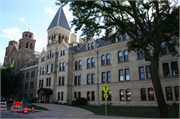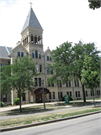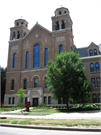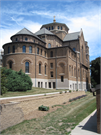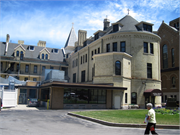| Additional Information: | A 'site file' exists for this property. It contains additional information such as correspondence, newspaper clippings, or historical information. It is a public record and may be viewed in person at the Wisconsin Historical Society, State Historic Preservation Office.
Built for the School Sisters of St. Francis. Addition to south wing cost $66,000.
Convent - 1890 and later.
Chapel - 1914-17.
Chapel architect: Brust and Philipp.
Convent, built in several sections incorporating Romanesque Revival forms; constructed of Cream City Brick with yellow brick additions. The chapel, of brown textured brick with carved stone trim, follows Italian Romanesque prototypes and is a good example of that revival style.
The School Sisters of St. Francis teaching order originally formed in Munich, Germany. Its founding nuns emigrated to Wisconsin after German Chancellor Otto Von Bismarck launched his “Kulturklampf” to control Germanic culture in 1872. Its provocative May Laws placed education under state control, forcing the school sisters abroad. The order settled in Campbellsport, then established its world headquarters in Milwaukee in 1886, dedicated to training teachers for religious schools. Their original convent burned to the ground in 1890 and was replaced in three stages by the building that extends north to Greenfield Avenue.
The St. Joseph Convent chapel highlights this religious education complex. Its conservative Romanesque Revival exterior gives little indication of the sheer splendor found inside. Fifteen kinds of marble from Italy, France, Switzerland, Greece, Mexico, and the United States ornament the chapel. Along with extensive mosaics, there are 115 lavish art-glass windows, made in Innsbruck, Austria. The Romanesque round arch repeats throughout the soaring nave in the vaulting, the clerestory, the arcades, and the reredos. The chapel’s exquisite acoustics are attributable to Mother M. Alfons Schmid, who established and fostered the convent's internationally recognized musical study program. |
|---|
| Bibliographic References: | PERMIT.
Pagel, p. 36.
Zimmerman #320.
"He Sent Two" p. 21.
National Register Nomination Form.
Perrin, Richard. Milwaukee Landmarks (1968), p. 23.
Milwaukee Houses of Worship Survey (UWM Department of Architecture, 1975).
Pagel, M.E. and Palmer, V.A., Guides to Hist. Milwaukee: Walker's Point and South (Milw. 1969) p. 36.
Buildings of Wisconsin manuscript.
Pagel, Mary Ellen & Virginia A. Palmer, University Extension University of Wisconsin, Guides to Historic Milwaukee: Walker's Point and South, 1969. |
|---|

